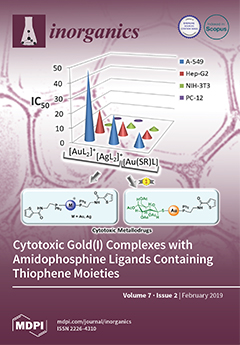Reaction of the
o-[(
o-hydroxyphenyl)methylideneamino]benzenesulfonic acid (H
2L) (
1) with CuCl
2·2H
2O in the presence of pyridine (py) leads to [Cu(L)(py)(EtOH)] (
2) which, upon further reaction with 2,2’-bipyridine (bipy), pyrazine (pyr), or piperazine
[...] Read more.
Reaction of the
o-[(
o-hydroxyphenyl)methylideneamino]benzenesulfonic acid (H
2L) (
1) with CuCl
2·2H
2O in the presence of pyridine (py) leads to [Cu(L)(py)(EtOH)] (
2) which, upon further reaction with 2,2’-bipyridine (bipy), pyrazine (pyr), or piperazine (pip), forms [Cu(L)(bipy)]·MeOH (
3), [Cu
2(L)
2(μ-pyr)(MeOH)
2] (
4), or [Cu
2(L)
2(μ-pip)(MeOH)
2] (
5), respectively. The Schiff base (
1) and the metal complexes (
2–
5) are stabilized by a number of non-covalent interactions to form interesting H-bonded multidimensional polymeric networks (except
3), such as zigzag 1D chain (in
1), linear 1D chain (in
2), hacksaw double chain 1D (in
4) and 2D motifs (in
5). These copper(II) complexes (
2–
5) catalyze the peroxidative oxidation of cyclic hydrocarbons (cyclooctane, cyclohexane, and cyclohexene) to the corresponding products (alcohol and ketone from alkane; alcohols, ketone, and epoxide from alkene), under mild conditions. For the oxidation of cyclooctane with hydrogen peroxide as oxidant, used as a model reaction, the best yields were generally achieved for complex
3 in the absence of any promoter (20%) or in the presence of py or HNO
3 (26% or 30%, respectively), whereas
2 displayed the highest catalytic activity in the presence of HNO
3 (35%). While the catalytic reactions were significantly faster with py, the best product yields were achieved with the acidic additive.
Full article





